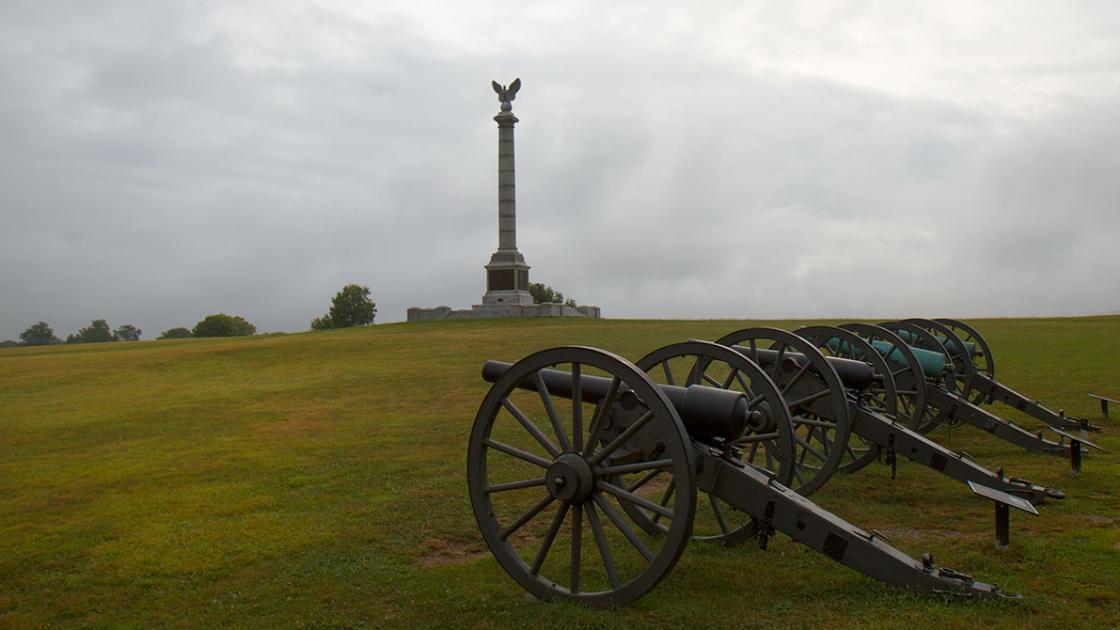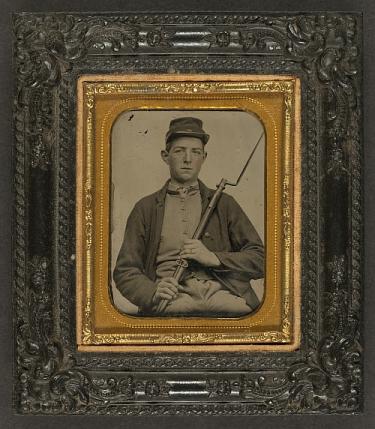
Our Division is on the Extreme right of the Right Wing ... it is a solid mass of tents here as far as the eye can see...
Samuel Fox, 6th New Jersey Volunteers, 1862
Did you know that you can experience many of the same sights that civilians and soldiers would have encountered during the Civil War? Use this list to guide your visual exploration.
Preserved Battlefields
The Civil War was fought over four long years and consisted of hundreds of thousands engagements. Many of the significant battles occurred east of the Mississippi River, but the conflict spread as far west as California.

See it today: Visit the numerous National Battlefield Parks held in trust by the National Park Service and observe the landscapes experienced by Civil War soldiers. As you traipse across the hallowed grounds of history, imagine yourself as a Confederate soldier taking part in Pickett's Charge, looking toward Cemetery Ridge as you march for a mile across an open field, or as a Union solider making a charge up Cheatham Hill during the Battle of Kennesaw Mountain. Be sure to fully utilize your visit with the assistance of an experienced interpretive guide, a park ranger, or the American Battlefield Trust's BattleApps.
Preserved weapons, gear, and uniforms
Though the carnage and bloodletting of the American Civil War ceased nearly 150 years ago, hundreds of thousands of artifacts have survived to this day. Muskets, cannons, jacket buttons, swords, caps, bayonets, and many other preserved items can be enjoyed thanks to the work of dedicated historians, museums, and private collectors.
See it today: Museums throughout the United States, in both metropolitan areas as well as on battlefields, offer creative and instructive Civil War exhibits, featuring rifles, uniforms, and camp gear, among other acountrements. Be sure to visit one of these many Civil War collections and discover what amazing stories a soldier's uniform, belt buckle, rifle, and haversack can tell.
Re-enactments
Envision tens of thousands of men donning the blue and gray crashing fearlessly into one another, with the sound of beating drums, roaring muskets, and booming artillery echoing in your ears. Though such imagery may elicit thoughts of a time long gone by, such are the scenes recreated by Civil War re-enactors. Reenacting began to spike in the 1960s, and in 1998, the 135th anniversary re-enactment of the Battle of Gettysburg drew between 30,000 and 41,000 re-enactors, with more than 50,000 spectators.

See it today: Re-enactors continue to organize events on a regular basis - everything from the annual re-enactment of the Battle of Gettysburg, to various special events held throughout the country. Look for re-enactments in honor of major battle anniversaries like the battles of the Wilderness, Gettysburg, Cold Harbor, Cedar Creek and Antietam just to name a few.
Movies and Documentaries

A wealth of dramatic and educational movies and documentaries have been produced about the Civil War. While some movies take audacious liberties regarding historical accuracy, many provide a compelling medium through which we can develop a better understanding of life during the Civil War.
See it today: Movies revolving around the Civil War have been produced since the very conception of the film industry. Silent films, such as The Birth of a Nation (1915) and The General (1926), were two of the very first pictures to center upon the war. Later, more famous Civil War films were produced including Glory (1989), Gettysburg (1993), Ken Burns' documentary series The Civil War (1990), and the more recent Steven Spielberg film Lincoln (2012). Be sure to also watch the American Battlefield Trust's In4 and War Department videos which address many intriguing subtopics of the conflict.
Original Documentation
Just as many of the Civil War’s weapons and equipment have been preserved, so have many of the original documents produced during the conflict. Maps, orders, journals, soldier and civilian letters, and other accounts survive in collections throughout the country.
See it today: Visit the Library of Congress or the Smithsonian's National Museum of American History and you'll be granted the opportunity to peruse a mountain of primary source documentation relating to our nation's deadliest conflict. Other national, state, and local museums feature thousands of Civil War period documents, letters, and soldier diaries which you can likewise observe at your own leisure.

Original Photographs
The Civil War was the first major conflict to be documented through the medium of photography. As a result, there are still many original Civil War photographs viewable today, both online and in museums around the country. Surviving images capture subject matter ranging from the mundane existence of soldiers in camp, the ravages wrought by disease and malnourishment on prisoners of war, to the horrific carnage filled scenes following a battle.
See it today: Luckily, The Library of Congress and National Archives both contain extensive collections of original Civil War images. The American Battlefield Trust also has a dedicated hub featuring 3-D photos from the Civil War, where you can enjoy perusing many photographic reminders of the war.


